|
Investigation of George
Ritchie's NDE OBE
Contents
What's
new?
Research
summary
One of the
earliest
detailed accounts of a near-death experience (NDE) was
that of Dr. George Ritchie which occurred in December 1943, published
in the book Return from Tomorrow
(R1: Ritchie and Elizabeth Sherrill, 1978). Ritchie wrote more
details of his story in a later book, Ordered
to Return
(R2: Ritchie, 1998). A major feature of his NDE was an
extensive out-of-body experience (OBE) at the beginning of the NDE.
In December 1943,
Ritchie was
in Army basic training at Camp
Barkeley outside of Abilene, Texas, when he had the opportunity to get
further medical training in Richmond, Virginia. Unfortunately he
contracted
severe double pneumonia shortly before he was to travel back east. He
collapsed in the x-ray department of the station hospital and was
placed in an isolation cubicle in a nearby ward
building. During
the early morning ward rounds, the ward man found Ritchie with
no
pulse, respiration or blood pressure. Ritchie was pronounced dead by
the
medical officer. After about 9 minutes, as a last resort, the doctor
injected adrenalin into his heart muscle. Ritchie's NDE apparently
occurred in the 8 or 9 between when the ward man found his body and the
injection with adrenalin.
After collapsing,
Ritchie
remained unconscious for about 24 hours, but "woke up" and sat
up
on the edge
of his bed. He noticed
that there was someone lying in the bed he just rose out of. Ritchie
remembered he had missed his train. He rushed out of the rear door of
the ward building and found himself apparently "flying" about
500
feet in the air. He appeared to "fly" many miles eastward from the Camp
Barkeley
station hospital over the frozen Texas plains, passing over a town with
multiple blinking caution lights, and stopped at a city on
the eastern shore of a large river, above an all-night cafe. He
realized that he could not be seen by other people and that his "body"
did not interact with physical objects. He subsequently "flew" back to
the station hospital he had left and had an extensive
near-death experience, visiting other realms in the presence of a Being
of Light whom he identified as Christ.
Ritchie recovered
from the
illness that had precipitated his NDE and, ten months later, as he
drove through Vicksburg,
Mississippi on the way back to Camp Barkeley, he recognized the layout
of the city and the river and then found the all-night cafe he had
stopped at during his NDE "flight".
A key aspect of
Ritchie's OBE is that he recognized that he was "flying" eastward by
the position of the North Star to his left. The evidence we have
compiled suggests that the
all-night cafe was exactly
due east of the likely ward building door Ritchie left during his OBE.
Our research
question was: can we verify any of the facts that Ritchie recounted in
his story, in particular about the details of his description of the
all-night cafe in Vicksburg, the town with several blinking caution
lights, and the Camp Barkeley station hospital ward
building. We spoke briefly with Dr. Ritchie in November 2006
about whether he could recall other features of the night sky during
his OBE, such as the position of the moon that night (which was
visible, having risen around 1:50 am) or the orientation
of the Big Dipper constellation. He did not recall any such details as
he was looking down at the ground during his "flight" (Ritchie, 2006).
We did not ask about the all-night cafe or the ward buildings,
and unfortunately Dr. Ritchie subsequently died in October 2007.
What we have
found is that there was indeed a restaurant or cafe, located at 1501
Levee St in
Vicksburg, called "Mike's Place", that very likely was an all-night
cafe in December 1943.
However, its construction was different from the description Ritchie
gave in 1978. The other possibilities for
cafes at that time (1943-44) do not fit Ritchie's story: all of the
other
possibilities are located on east-west streets (wrong direction), or on
the
wrong
corner, or are the wrong construction or color (e.g. brick).
The Camp Barkeley
station hospital was spread out over several city
blocks, perhaps an area of 80-90 acres. From an aerial photograph of
the hospital
taken in 1943, matched with a current satellite photograph of the site,
we have identified one ward building in the
hospital complex, out of approximately 85, whose rear door is
at the exact same
latitude
(32o
20' 54" N) as the front of 1501 Levee St.
That ward building was close to
the likely location of the hospital's x-ray department. Ritchie wrote
in 1978 that he had been
placed in an isolation cubicle near the x-ray department where he had
collapsed. In addition, Ritchie's account that he
passed over a town with multiple blinking caution lights during his
"flight", is consistent with this exact latitude, which passed just
south of the main street in Tyler, Texas. There were four traffic
lights along that path at the time in Tyler, which were set to
blinking at night.
Implications
The OBE portion
of Ritchie's NDE
is very unusual in that it involves the experience of
being out of his body, traveling to a distant location (523 miles
away)
and seeing details of an unfamiliar area, apparently very accurately.
What is most striking is that the location of
the cafe from the likely station hospital door appears to be exactly
due east, and the location of the blinking caution lights is
also at this precise latitude. Indeed,
the
maximum deviation from the hospital to Vicksburg could have been only
0.6 seconds of arc, or 2900 feet over 523
miles of travel. The fact that three key
aspects of Ritchie's account have likely correlates at the exact same
latitude, occurring at widely spaced intervals, and that Ritchie
reports having traveled east strongly suggest
that his "flight" was an objective
albeit unusual event.
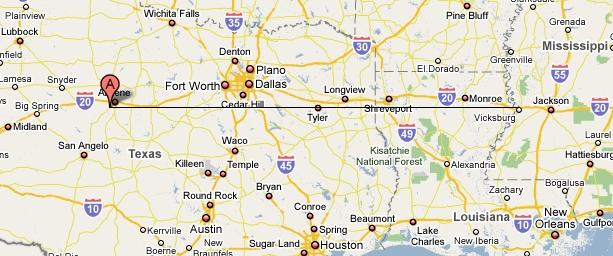 |
| Map of the path
directly
east
from Camp Barkeley (southwest of Abilene) to Vicksburg (just north of
the I-20 bridge across the Mississippi River), approximately 523 miles.
This path passes through Tyler, Texas which in 1940 had a population of
28,300. In 1940, Abilene's population was 26,600 and
Vicksburg's was 24,500. |
Ritchie's
immediate impulse on "awakening" in the ward building was that he had
to get to Richmond whatever way he could. Evidently, in his mind,
Richmond was "east", even though he did not know exactly in what
direction Richmond actually was from the camp. What is striking is that
the mind evidently can subconsciously
determine directions
very precisely, even when the ordinary
conscious mind cannot.
Ritchie's
experience is a
striking example among
many NDE accounts where the experiencer's will or intention appears to
operate immediately and precisely in response to a felt desire.
Ritchie's
account contains other examples of this phenomenon as well: upon
wishing to go down to the city to find someone to give him directions,
he immediately slowed down and stopped above the all-night cafe (R1, p.
39); upon feeling intensely that he had to get back to the station
hospital, he immediately found himself traveling rapidly back (R2, p.
30), arriving at the hospital's main entrance.
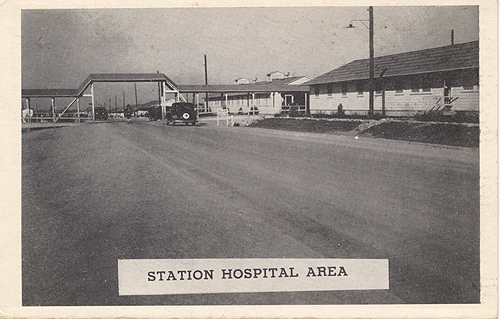 |
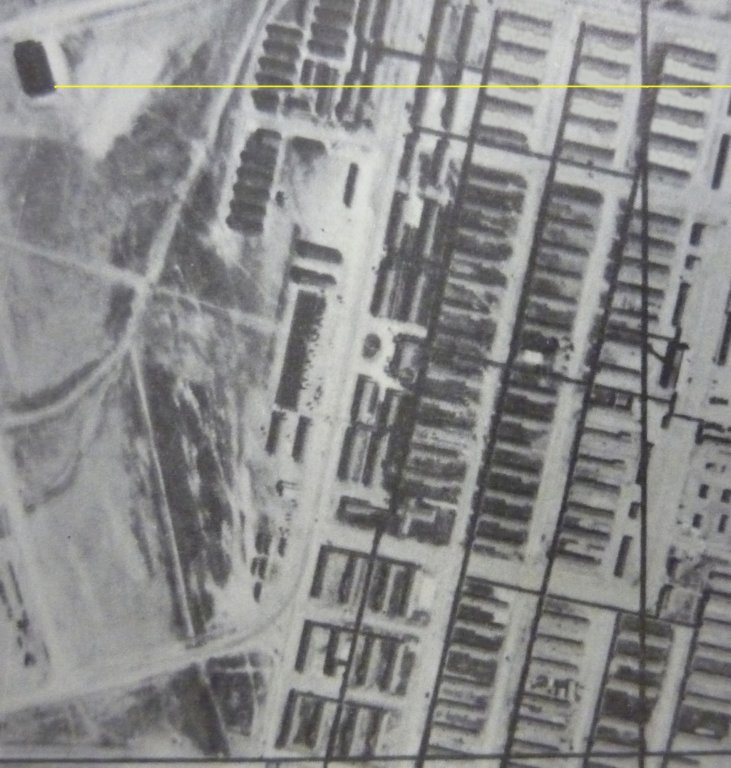 |
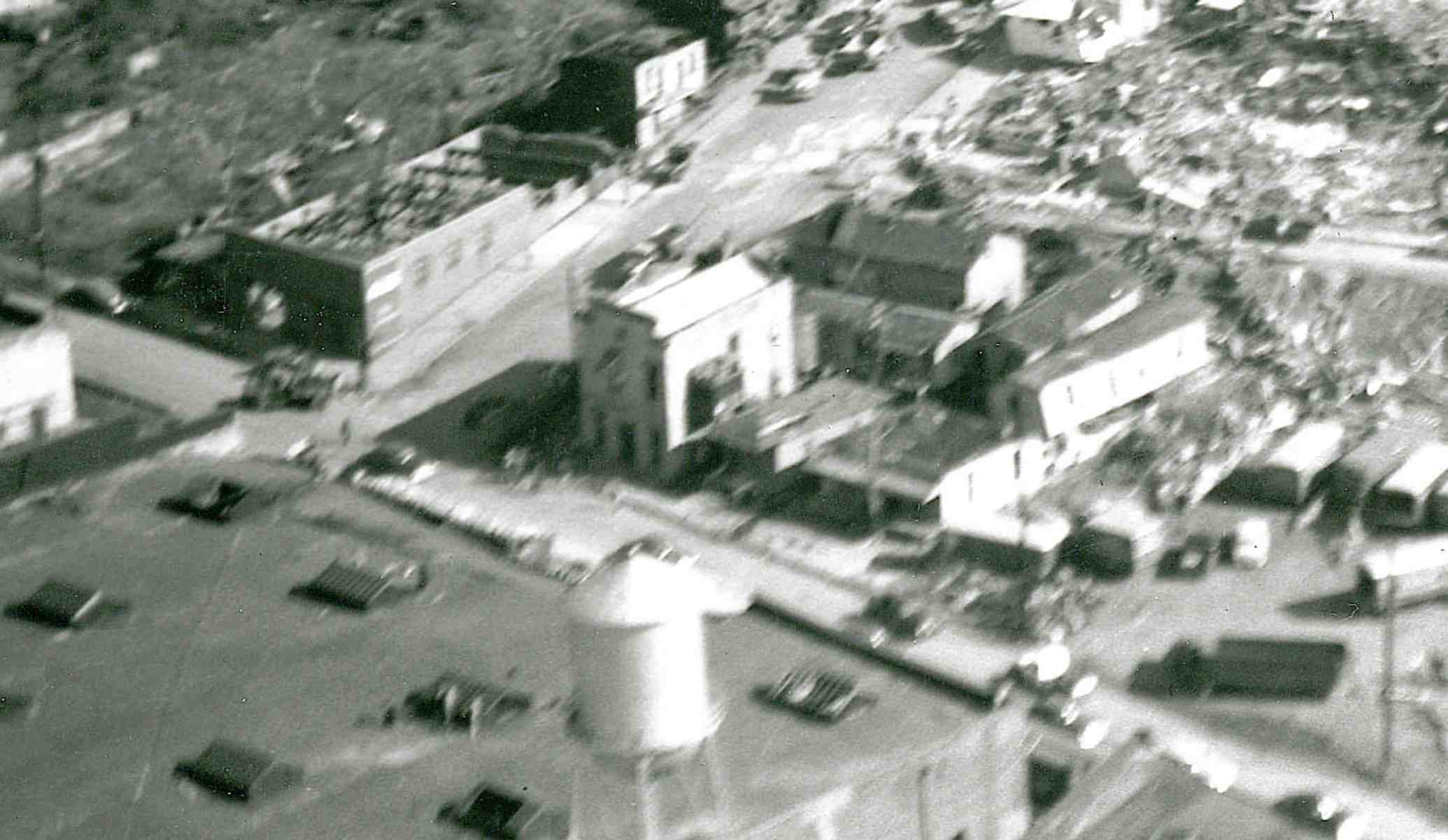 |
| Barkeley
station hospital area, near the probable location of Ritchie's ward
building; showing a covered walkway across the main street, between
buildings. |
1943
aerial
view of hospital complex (on right of photo). Ward buildings run
east-west. Yellow line is the same
latitude as 1501 Levee St and crosses the rear door of leftmost ward
building, third from the top. |
Aerial
view of 1501 Levee St after the tornado of 1953 (the small, light
colored
building in center, at the corner of two streets (Levee St and South St) |
Thus if one
accepts that Ritchie's account is true of flying over the
Texas and Louisiana landscape to an all-night cafe in a city
on
the other side of a broad river, which he later verified by locating
the cafe in Vicksburg -- in other words, if one accepts that Ritchie's
mind in some way separated from his physical body at the time he was
pronounced dead and had veridical perceptions of a location many miles
away, then it also implies that his mind had access to
specific
knowledge (the precise direction of east) which no one ordinarily has.
If the mind can separate from the physical body and operate
independent of it, then the simple intention or desire to do
something appears to work immediately and can draw upon knowledge
beyond the reach of ordinary consciousness.
Further
work
We are trying to
verify more strongly the details and location of the all-night
cafe and pinpoint the station
hospital ward building in more
detail. In
Vicksburg, we continue to
focus on the 1501 Levee St property:
- Why are Ritchie's two descriptions of the cafe
different in significant details?
- Can we get a
better photograph of the front of
1501 Levee St and determine the color of the building's front and
roof?
- Can we verify that "Mike's Place" was indeed an
all-night cafe in 1943
with a blue neon Pabst sign in the right window?
- Can we identify the particular Pabst Blue
Ribbon Beer neon sign that was in common use in 1943-44? (Possibilities are listed here).
We would like to get a
description of the location of the buildings at the Camp
Barkeley station hospital:
- Can we find a site plan showing the location of
specific
buildings, in particular the x-ray department?
- Can we locate detailed floor plans for the ward
buildings?
- Is it possible that Ritchie's medical records
might be archived which would show which ward he was in when he "died"?
Comments on our work are welcome! Please feel free to
comment on our Discussion
Group on the Self-Conscious Mind.
Robert
and Suzanne Mays
top
George
Ritchie's out-of-body experience
In December 1943,
Ritchie was in Army basic training at Camp
Barkeley outside of Abilene, Texas, when he had the opportunity to get
further medical training in Richmond, Virginia. Unfortunately he
contracted
severe double pneumonia shortly before he was to travel back east, and
in the early morning of December 21, 1943, he was found to have no
pulse, respiration or blood pressure and was pronounced dead by the
medical officer. After about 10 minutes, as a last resort, the doctor
injected adrenalin into his heart muscle. Ritchie miraculously revived,
although it took several days for him to regain consciousness and
several weeks for him to recover and finally get to
Richmond. His medical case was attested to in affidavits by the medical
officer in charge of the ward area he was in, Dr. Donald G.
Francy,
and the nurse who cared for him, Lt. Retta Irvine (R2, p. 25;
Spraggett, 1974, pp. 68-69).
The eastward
flight
Ritchie had been
unconscious but "woke up" and sat up on the edge
of his bed. It was about 3 AM, Tuesday, December 21, 1943 (R1, p. 78).
He noticed
that there was someone lying in the bed he just rose out of. He
remembered he had missed his train east and he felt driven to get to
Richmond whatever way he could. He tried to get the attention of the
ward man who was walking through the corridor, but the man walked right
through him. He ran through the metal door of the ward and found
himself flying east about 500 feet in the air (R1, p. 38; R2, p. 29).
He knew he was going
east
because the North Star was on his left (R2, p. 29). He looked down as
he passed
over snow-dusted fields and partially frozen streams. He passed over a
town with caution lights blinking at the intersections. The countryside
then appeared more wooded. Further on, he came
to a broad river with a bridge over it and, on the far bank, a large
city. He decided to
stop and get directions, since he didn't know exactly how to get to
Richmond.
He somehow slowed down and found himself looking down from about 50
feet directly above
a white, rectangular single-story building with a red roof that was
situated on the
corner where two streets came together (R1, p. 39; R2, pp. 25, 29). The
blue light of a Pabst Blue
Ribbon Beer neon sign and the light from the window cast out on the
ground. The all-night cafe had two windows with a door in the center.
The Pabst neon sign was in the right window (R2, p. 29). (There may
also have been
a neon sign above the door, "Cafe" (R1, p. 39)). Ritchie saw a man in
an
overcoat but no hat walking briskly down the sidewalk toward the cafe.
He wanted to speak to him and he found himself light down about 12 feet
in front of the man and then walked along side him, trying to ask him
what city this was and how to get to Richmond. The man didn't hear him
and also walked through him; Ritchie tried to touch his shoulder as the
man opened the door to the cafe and found his hand went right through
him. Nearby there was a telephone pole with a guy wire. Ritchie leaned
on the guy wire to think and found that his hand went right through it.
Ritchie now realized that he had left his physical body back in the
Camp
Barkeley station hospital and thought he needed desperately to go back
there. He then found himself flying back more quickly than he had come
and ultimately found his body in an isolation cubicle with the sheet
drawn over the face. He recognized that this was his body, from his
college fraternity ring on the left hand. He went on to have a very
profound experience which began with a meeting with Jesus Christ and
was ultimately told that he had to return to his body.
Ritchie's
experience
probably took place in the 8 or 9 minutes from when he was first
pronounced dead to when the doctor returned and injected his heart.
Return
to Vicksburg, ten months later
About 10 months later, after he had recovered but had flunked out
of medical school in Richmond, Ritchie and three other soldiers were
assigned back to Camp Barkeley. On October 23, 1944, they drove from
Cincinnati through Memphis, along the Mississippi River and stopped
overnight about 9 p.m. in Vicksburg. In the morning they were driving
through Vicksburg along the river with Ritchie sitting in the back left
seat (R2, p. 51).
In the city Pete
[the driver] took a street leading down toward the
river.
"See any signs?" he asked me over his
shoulder. From my position
in the back of the seat I was supposed to keep an eye out the left-hand
window. I didn't answer. For the last mile my mouth had been feeling
dry, my stomach tight. Something about the layout of this town seemed
strangely, impossibly familiar: I knew I had never been there before,
and yet I knew exactly how the shoreline would look around the next
curve. How the streets would intersect. There! Just as I'd known they
would! And all at once I knew for sure that straight ahead on that very
street we would come in a few blocks to a white frame building with a
red roof and the word "Cafe" in neon letters over the door.
"There it
is! To the left!" The guy in the front next to Pete pointed to a small
sign at the corner. "The bridge must be back up that way." Pete slowed
the car and put out his hand to signal a left-hand turn.
"Please!" My
voice was harsh. "Don't stop, Pete! Keep going straight." The guy who
had seen the sign turned around to stare at me. "The sign points up
that way." "I know. I--I'd just like to drive another couple of blocks
in this direction, that's all." Everyone in the car was looking at me
now. "I thought I recognized something," I said. Pete shrugged and
straightened the wheel. "How much farther?" he said, driving slowly
ahead. My heart was hammering too hard to speak. A block ahead, on my
side of the car, on the corner, was a white all-night cafe with a red
roof. The neon letters over the door were turned off in the bright
daylight but the Pabst sign was still propped in the right-hand window.
There was the sidewalk where I walked beside a man who could not see
me. There was the telephone pole [and guy wire] where I had stood so
long . . . how long? In what kind of time and what kind of body?
"Stop!" I cried. For Pete was passing the little restaurant. (R1,
pp. 97-98).
Camp
Barkeley Station Hospital
The 2300-bed Barkeley station hospital consisted of numerous one-story
buildings for admissions, surgery, laboratories, clinics, x-rays,
dining, administrative
offices, officer and nurse quarters, storage, a post exchange and a
movie theater. The construction was "theater of operations" level
construction. The hospital's ward
buildings were one-story 24-bed barracks. In the aerial photograph of
the hospital area, there are over 85 such ward buildings. We estimate
that each ward building was long and narrow, approximately 24' x 120'.
The hospital
buildings were interconnected with one another by connecting walkways
which can be seen as black lines running between the front of the
buildings. A post card of the hospital area shows a covered walkway
running across the main road of the hospital between the main complex
on the right and what we surmise were the nurses' quarters on the left.

|
larger
image (3M) 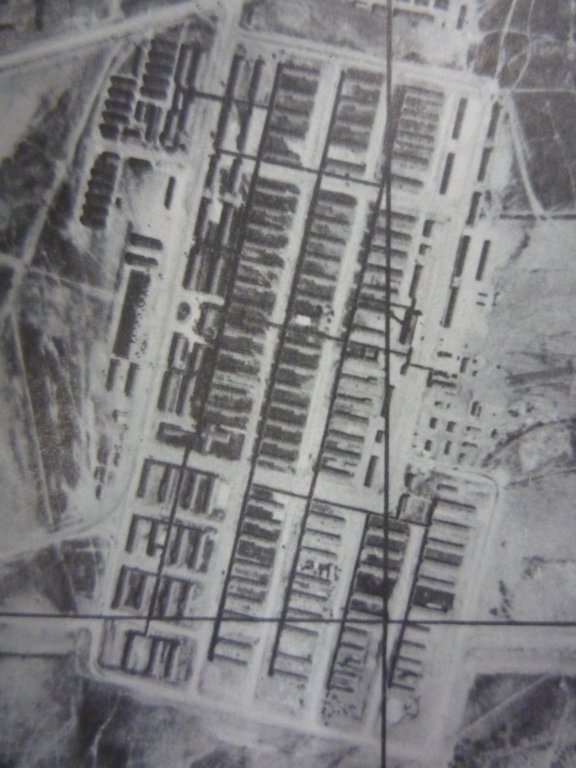
|
| Post
card of station hospital
area showing covered walkway across the main road. This view is facing
north. This area is shown
in the upper left of the aerial photograph (right) where a dark line
crosses
the main road. The area to the right of center is probably
the emergency entrance of the hospital. |
Aerial
photograph of station
hospital from 1943 (north at top). The north-south
distance on this photograph is about 3000 feet (0.6 mi). The ward
buildings run
roughly east-west. The covered walkways can be seen as dark lines
running between the buildings. (Note the added longitude and latitude
lines.) The
main hospital entrance was probably the circular driveway off the main
road on the western side of the complex, about half-way down. Shadows
are cast approximately toward the northwest. |
The connecting corridors opened into each ward building. At the front
of the ward building was an interior hallway, on one side of which were
three
offices, for the doctor, nurse and ward man; on the other side of the
hall were three small isolation cubicles reserved for the most serious
cases. The corridor then opened through two glassed doors to the ward
area containing 24 beds, each with a chair, a table and a small
night-light. Although Ritchie does not describe it in detail, we assume
that another hallway led from the other side of the ward area to
lavatories, showers, a linen and supply area and a small kitchen. At
the other end of the building
was a metal door leading to the outside (see R1, pp. 19, 27, 38; R2, p.
28). Apparently other ward buildings in the hospital had 36 beds. There
was
sufficient space between the buildings to have windows to the outside
on both sides and frequently a south-facing sun porch (Rees,
1943), which can be seen in the aerial photograph. We estimate that the
distance
between the ward buildings was about 75'.
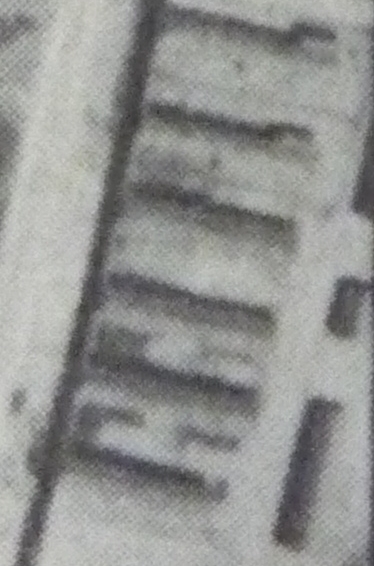 |
 |
| Detail
of
aerial photo of station hospital from 1943 (north at top). Shows six
ward
buildings (long and narrow, oriented E-W) connected by walkway
(black line going N-S). The top two wards have a small addition on the
NE wall. The dark areas between some wards are variations in the
ground color. To the east of the ward buildings are a large and small
storage building running N-S. |
Detail
of a panorama of Camp Barkeley taken from one of the camp's two water
towers by E. O. Goldbeck Photo in February 1942 when the camp was still
under construction (facing southeast). This area shows the central part
of the station hospital complex. The main road is in the
foreground, the likely hospital entrance with circular drive
is on
the right. Two long, narrow buildings running N-S are in the foreground
in the center, with a connecting walkway (not yet enclosed) between
them. Behind these two buildings are several ward buildings running
E-W. The walkways running in front of these ward buildings (also not
yet
enclosed) can also be seen. The power plant with the large smokestack
is seen in background on the left. All of these buildings can
be
seen on the aerial photo as well. |
Ritchie's
experience at the
station hospital
Just before Ritchie was to leave the hospital to catch the train to
Richmond, he was found to have a fever of 106.5oF.
He was taken by ambulance to the x-ray department where he fainted as
the doctor took his chest x-ray. He was placed in a ward building near
the x-ray department, in one of its isolation cubicles (R1, p. 78). He
remained unconscious for the next 24 hours until he had been
found by the ward man with no pulse, respiration or blood pressure and
was pronounced dead twice by the medical officer of the day (R1, pp.
78-79).
It is fair to say the Ritchie had been obsessing about catching the
train to Richmond for several days as he tried to recuperate from his
respiratory infection, even up to the moment he collapsed in the x-ray
department (R1, pp. 20-23, 26-35; R2, pp. 20-23). Upon "waking up", his
first thoughts were: Where is my stuff, where are the train schedules,
where is my watch? I've missed the train! (R1, p. 36). He then rushed
out the rear metal door of the ward building: "Even if I had missed
that train, I'd find some way of getting to Richmond!" (R1, p. 38).
Immediately upon leaving the ward building, Ritchie found himself
traveling at great speed toward the east about 500 feet in the air (R2,
p. 29), and stopped when he had come to a very broad river with a city
on the opposite shore.
In front of the all-night cafe, Ritchie realized that he had left his
physical body back in the station hospital and he felt strongly "I have
to get back to that hospital." He immediately found himself
flying westerly even faster than he had come and found himself standing
in front of the station hospital (R2, p. 30). Inside, he found the
admissions department and, to the left, the staff dining room (R1, pp.
41-42). He wandered through many ward buildings searching for his body.
He eventually came to the x-ray department and, proceeding further,
came to a ward building where his body lay in one of the isolation
cubicles. Although the sheet had been pulled over the head, Ritchie
recognized his chipped fraternity ring on the left hand (R1, pp. 45-46).
Ritchie's
possible ward
building at the station hospital
From the aerial photograph of the hospital area, the
main hospital entrance appears to be the circular driveway off the main
road on the western side of the complex. If Ritchie had searched in a
general direction to the left (heading north) he would ultimately have
reached a ward building that matches the latitude of 1501 Levee St. The
x-ray department would very likely be one of the buildings which is
relatively near the hospital admissions building and accessible by
ambulance, perhaps accessible from the main road near where the
postcard photo was taken, and could thus have
been along the way as
Ritchie searched for his ward building.
To find if there was any overlap of ward buildings with the likely
all-night cafe, we located a nearby landmark on the current satellite
image of the camp in GoogleEarth. Fortunately the southeast corner of
the concrete foundation of a large building, probably one of the camp's
larger movie theaters, lies on the latitude of 1501 Levee Street. From
this location on the 1943 aerial photograph, we drew a line parallel to
the latitude line in the aerial photograph. To show the ward buildings
more clearly, we lightened the ground areas between them in the top of
the photograph. From this line, we find that this latitude
appears to
cut through the rear door of the west-most ward building, the third
down from the top. Interestingly, this building is the first ward
building one comes to from the entrance shown in the postcard photo.
This secondary entrance was probably the hospital's emergency entrance.
Various emergency services including x-ray would likely have been
situated
in buildings off this entrance.
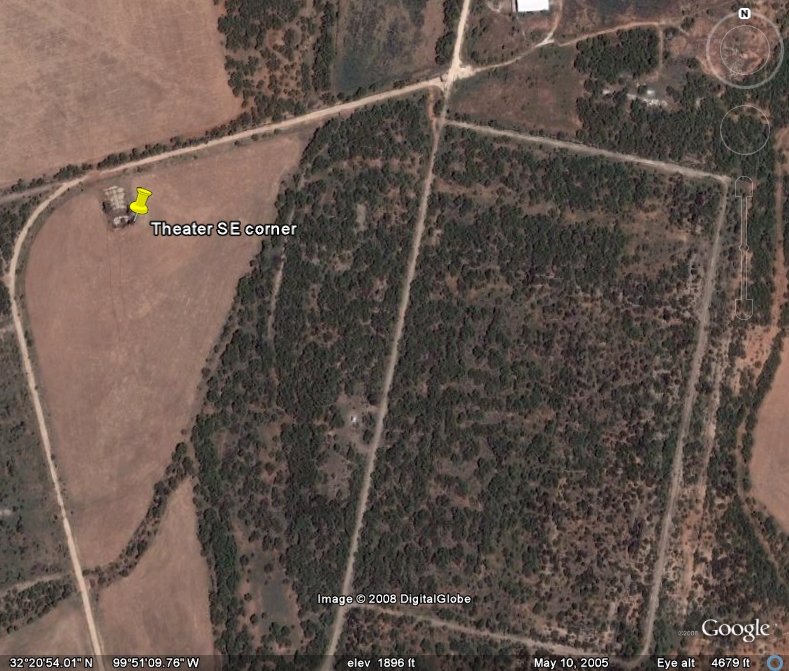
|

|
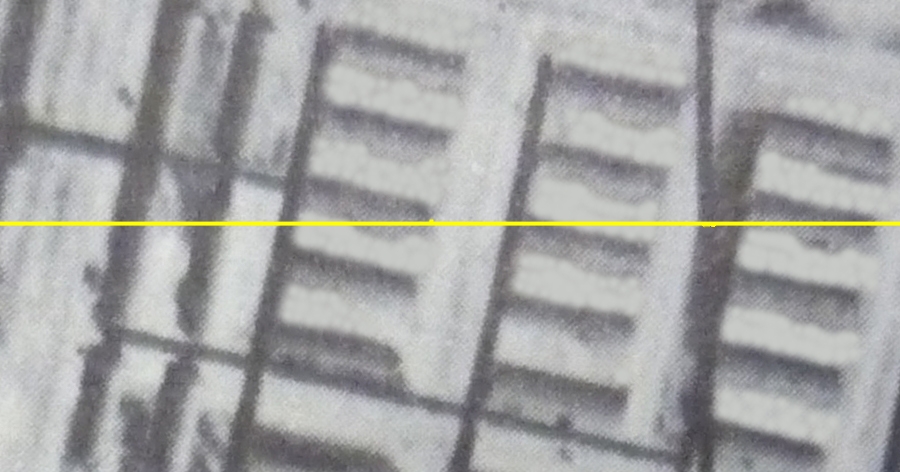 |
| Current
satellite image of hospital area from GoogleEarth, showing foundation
of theater building on the left and pin near the southeast corner
marking the latitude of 1501 Levee St in Vicksburg, namely 32o
20' 54" N. |
Aerial
of hospital showing
the southeast corner of the theater building and a parallel yellow line
drawn from it. This line
appears to cross the west-most row of ward buildings at the center of
the third ward building down. Larger
image (2.0M) |
Detail
of yellow latitude line as it crosses the hospital ward buildings. The
areas between these ward buildings have been lightened from
the
original to highlight the buildings.
The ward building of interest is the third building from the top in the
left-most row of buildings and has a small yellow dot at the center of
the roof at the rear exit. |
Did Ritchie "fly"
over Tyler, Texas?
Two
features Ritchie mentioned about his "flight" across the plains of
Texas were: " A town
flashed by beneath me, caution lights blinking at the intersections....
The
countryside
appeared more wooded now:
broad snow-dusted fields surrounded by dark trees. Occasionally I'd see
a road, but there was little traffic at this time of night, and the
towns I passed were dark and silent." (R1, p. 38, italics added).
Where
was the town with multiple blinking lights at its intersections? From
Ritchie's account, this appears to have occurred somewhere in the
middle of
the "flight". If we take the latitude of Ritchie's "flight" as the
latitude of 1501 Levee St, then Ritchie would have passed directly over
Tyler, Texas. In fact, he would have passed directly over streets that
are just two blocks south of Erwin St, the main street in Tyler at the
time. In the
1940 census, Tyler had a population 28,300 and was reported somewhat
larger than Vicksburg in population, manufacturing, wholesale
business and retail business.
According to a longtime resident of Tyler, in the early 1940s there
were four traffic lights in Tyler, three along Erwin St and one at
Front St and South Broadway Ave (McNamara, 2009). The signals were hung
in the center of
the intersections from cables from the four street corners, and were
set to blink at dark, after most of the traffic
had left,
such as when workers went home or when theaters let out. The buildings
in this area were
mostly one story with some two stories. Ritchie estimated he was
"flying" 500 feet in
the air and thus would readily have seen all four blinking traffic
signals along these two streets.
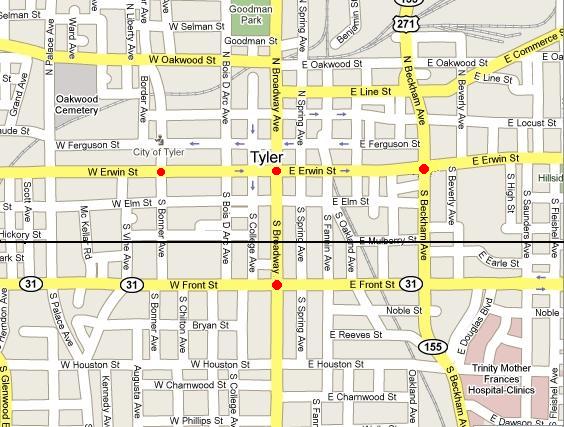 |
| Current
map of
Tyler, Texas (current population 108,800) showing the locations of the
four traffic signals that were in operation in the early 1940s and the
latitude line of
32o
20' 54" N which lies along the streets that are two blocks south of
Erwin St and one block north of
Front St. If Ritchie had been "flying" at night directly east along
this
latitude in 1943, he would have seen blinking caution lights at three
intersections along Erwin and one along Front St. |
The change in vegetation from central to east Texas and further
eastward that Ritchie reported is consistent with current vegetation
patterns in these
regions and may have been more pronounced during 1943, as north central
Texas had been part of the 1930s dust bowl.
Another possibility for Ritchie's observation of a town with multiple
caution lights is Cleburne, Texas, a town 30 miles south
of Fort Worth. In 1940, it had a population of 10,600 and had a major
rail
facility. Ritchie's "flight" along the latitude of 1501
Levee St would have taken him directly over the railroad intersection
with the main street, Henderson St. However, it is not clear that there
would
have been multiple blinking caution lights along this path.
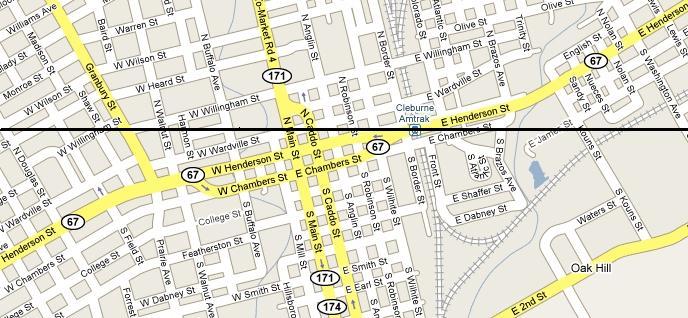 |
| Current map of
Cleburne, Texas (current population 29,000) showing the latitude line
of 32o20'
54" N which passes near or crosses over several main intersections.
Given
the smaller population in the 1940s it is less likely that
there
were multiple caution lights in this town. |
Tyler and Cleburne are the only towns along the east-west
path between the Barkeley station hospital and Vicksburg. The rest of
the countryside is essentially rural, with occasional hamlets at the
intersection of two roads.
Vicksburg
all-night cafe
We have concluded that 1501 Levee St was the likely all-night cafe that
Ritchie "visited" during his out-of-body "flight". To understand
Ritchie's account of the topography of the land, it is important to
note that most of Vicksburg lies on a plateau overlooking the Yazoo
River. The main north-south
street is Washington St. To the west of Washington St,
the land slopes fairly sharply down to the river. Levee St is the
west most street. Numerous industrial facilities were located between
Levee and the Yazoo River, including P. P. Williams & Co., a
very
large wholesale grocery company and Anderson Tully, a very large lumber
supplier.
Ritchie's
description of the
all-night cafe
In references R1 and R2, Ritchie gives two
descriptions of the all-night cafe with certain conflicting details.
The story in R1 (1978) was written by Elizabeth Sherrill based on two
lengthy interviews she had with Ritchie, in 1963 and 1977 (Sherrill,
2006). Overall, the second account of his experience (R2, 1991) appears
to provide
more details of a
corroborative nature (especially chapter 2) than R1, for example
including excerpts of the
notarized statements of Dr. Donald Francy and nurse Lt. Retta Irvine
(pp. 24-25), more details of the return trip
from Richmond to Camp Barkeley 10 months later (pp. 25-26, 51), and the
fact that he recognized he was traveling east by the
position of the North Star (p. 29). (In R1, Ritchie had noted that the
fact that Vicksburg was due east of Camp Barkeley was a significant
corroboration for him, but he didn't elaborate why.)
In chapter 2
of R2, Ritchie also provides the essential
corroborative
details of the all-night cafe which he recognized on the return trip:
the color of the building, the placement of the Pabst Blue Ribbon Beer
neon sign and the topographical location on the land as it related to
the Mississippi River (actually the Yazoo River runs by
Vicksburg
and then joins the Mississippi).
Thus, the details given in the second account (R2) appear to be more
accurate and Ritchie appears to have wanted to correct certain details
from the first account (R1), in order to "[remove] any
possibility of my experience being a delusion or a dream as so many
skeptics wanted to believe" (R2, p. 26). Even so, it is important to
examine the
conflicting statements about the all-night cafe since they will help
clarify the evidence for any particular candidate cafe.
In R1, Ritchie describes the cafe as follows: "Almost
immediately
I noticed myself slowing down. Just below me now, where two streets
came together, I caught a flickering blue glow. It came from a neon
sign over the door
of a red-roofed one-story
building with a "Pabst Blue Ribbon Beer" sign propped in the front window.
"Cafe" the jittering letters over the door read, and from the windows
light streamed onto the pavement. Staring down at it, I realized I had
stopped moving altogether. Finding myself suspended fifty feet in the
air was an even stranger feeling... I found myself down on the
sidewalk, hurrying along at the stranger's side... [I] leaned
up
against the guy wire of a telephone pole to think things through..."
(pp. 39-40, italics added). Upon driving through Vicksburg ten months
later: "I knew for sure that straight ahead on
that very
street we would come in a few blocks to a white frame building
with a
red roof and the word
"Cafe" in neon letters over the door... A
block ahead, on my
side of the car, on the corner, was a white all-night cafe with a red
roof. The neon letters
over the door were turned off in the bright
daylight but the Pabst
sign was still propped in the right-hand window."
(p. 98, italics added).
The description of the cafe in R1 is thus: a white one-story, frame
building with a red roof on the corner of two streets coming together,
on the east side of the street (visible from the driver's side of the
car). There was a blue neon sign "Cafe" over the door and a
"Pabst" sign propped
in the right-hand window. The cafe was located down by the river
because "Pete [the driver] twisted the wheel impatiently and followed
the signs back up the sloping streets to the bridge." (R1, p. 99), that
is, via
Washington St.
In R2, Ritchie describes the cafe as follows: "I came down in front of
a white, rectangular
all-night cafe. There was a front door, flanked by large windows. In
one window was a Pabst
Blue Ribbon Beer neon sign.
Ten months later, while driving through Vicksburg, Mississippi, on the
way from Cincinnati, Ohio to New Orleans, Louisiana (sic), I recognized
this same building. The color of the building
and the neon
sign were the same. The topographical location on the land as it
related to
the Mississippi River (sic) was the same." (pp. 25-26, italics added).
In describing the trip through Vicksburg ten months later: "We spent
Monday night in Cincinnati, Ohio, and then drove all day Tuesday,
arriving in Vicksburg, Mississippi, around 9:00 p.m. While driving down
the street the next morning, I could look over on the right and see the
Mississippi River (sic). Then I thought, "Something looks very familiar
to me." I looked over on the left and there stood the white all-night
cafe with the Pabst Blue Ribbon neon sign in the front window. I looked
down the river and there was the big bridge crossing the Mississippi,
the one I had seen that night I was trying to get back to Richmond."
(p. 51).
The description of the cafe in R2 is thus: a white rectangular
building with a red roof. There was a front door flanked by two large
windows, in one of which was a Pabst
neon sign.
The building was on the east side of the street, with the Yazoo River
to the west. Down from this location was the bridge over the
Mississippi.
Thus, the main discrepancies between the two descriptions are in the
size and construction of the building (one-story frame versus
"rectangular") and in the wording and placement of the blue neon sign
("Cafe" over the door versus "Pabst" in the window).Given that
Ritchie's second account of his story appears to include a
number
of points of clarification including the description of the all-night
cafe, it is reasonable to accept the second description as more
accurate.
Locating
the all-night cafe
The Vicksburg telephone directories up until relatively recently had
the useful feature of listing all buildings by address, as well as the
usual
listing of all businesses by business type (a "yellow pages"
directory).
Thus we can identify all of the candidate restaurants (which included
cafes and retail beer establishments) and also list all structures
which were located on a particular street. In this way we used the 1941
and 1944 directories (there were no directories in the intervening
years) to compile a list of all restaurants in the general downtown
Vicksburg area and particularly those restaurants that were located on
streets down the hill toward the river (Levee, Mulberry, Pearl and
low-numbered addresses on cross streets). Our list had 14 candidate
restaurants. All but one of these could be eliminated because they were
too far away from the river, were of the wrong construction (e.g.
brick, unpainted) or did not match the description in other ways, most
commonly that they were situated on the wrong side of the street or not
on a corner.
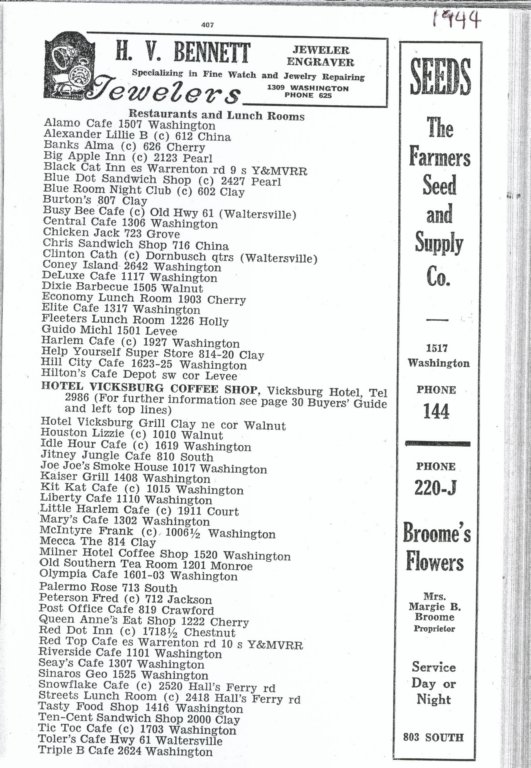 |
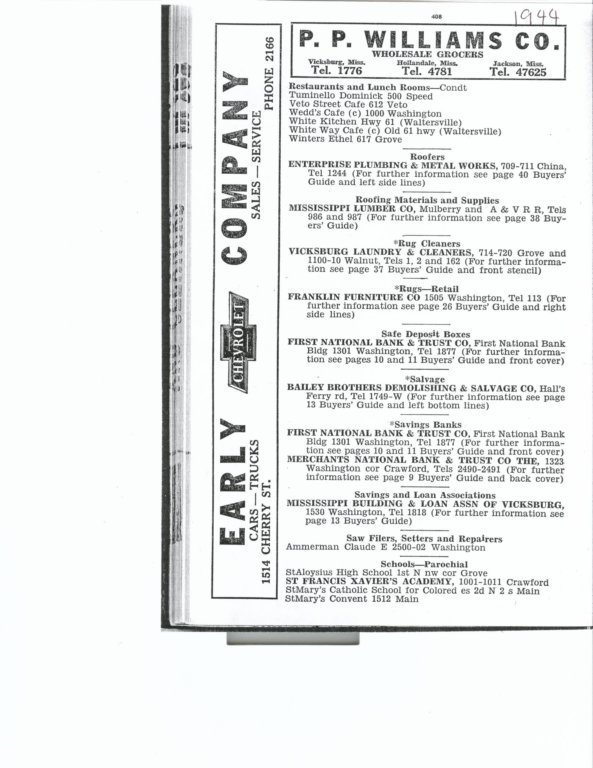 |
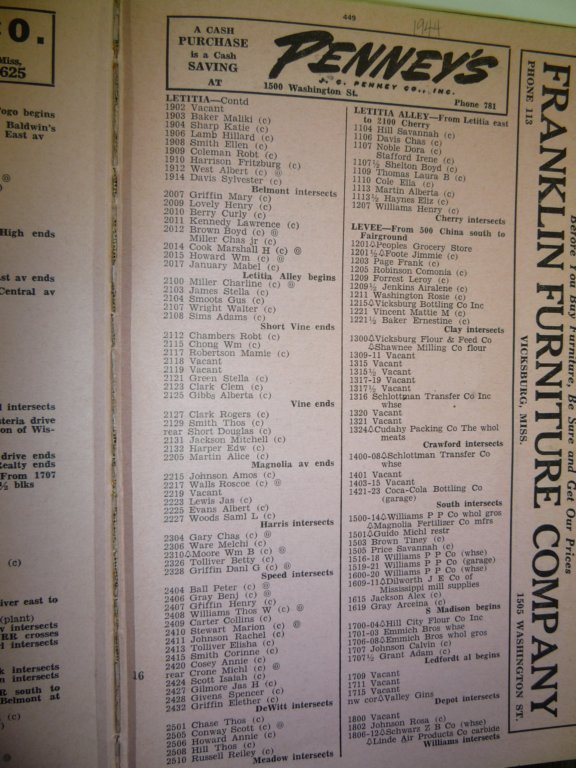 |
| 1944
Vicksburg directory of restaurants,
page 1 |
1944
Vicksburg directory of restaurants,
page 2 |
1944
Vicksburg directory of addresses on
Levee St ("c" stands for "colored") |
Given Ritchie's description of driving down to the river and then
turning around and driving back up the sloping streets to get to the
bridge, Levee St was the most likely location of the cafe.
Along Levee St, there were two candidates restaurants in 1944:
1501 Levee, listed under Michael Guido and Hilton's Cafe on the
southwest corner of Depot St and Levee St (318 Depot St). The latter
was a one-story frame building situated on the west side of Levee and
thus would not fit Ritchie's account of driving along the river, with
the river on the right and the all-night cafe on the left.
History
of 1501 Levee St
This leaves 1501 Levee St as the most likely
candidate, a building on the corner of Levee St and South
St.. For
the first 40 years of the last century, this location was a retail
grocery store. In 1912 and later in 1914, Ralph Romano and Rosa Setaro
purchased the two parcels at 1501-1505 Levee St. The previous structure
at 1501 Levee was replaced probably during this time by a two-story
concrete block building with a slate or tin roof. Concrete
block
construction began in Vicksburg around the 1915s and consisted
of
solid concrete blocks 8" x 8" x 12" whose outside face had the
appearance of
stone (Tuminello, 2008). The other buildings on the two parcels
consisted of six one-story frame structures housing eight African
American households. The building at 1501 Levee was listed as a retail
grocery store along with an upstairs residence through the 1941
Vicksburg directory. In 1941, it was owned by Eugene and Isabel
Breeden and was their residence.
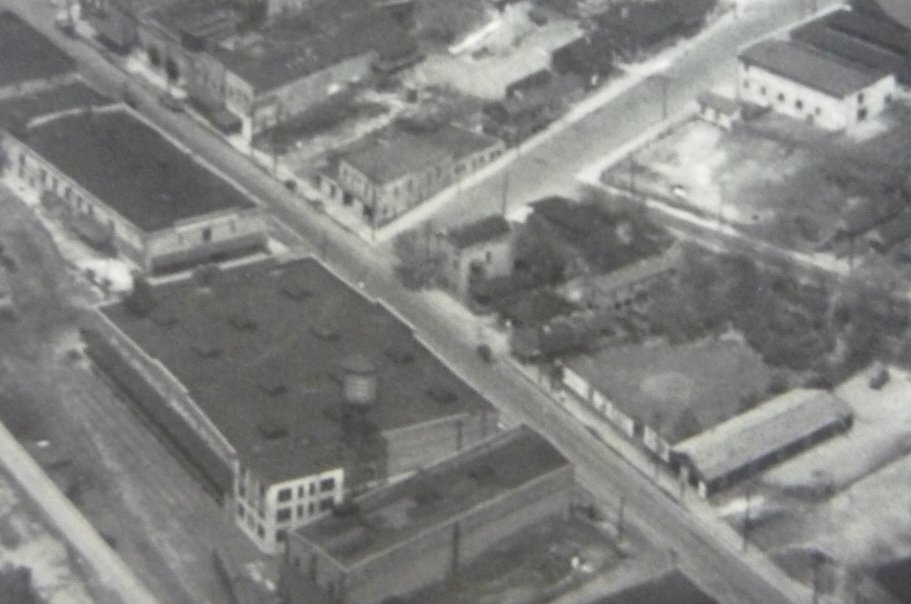 |
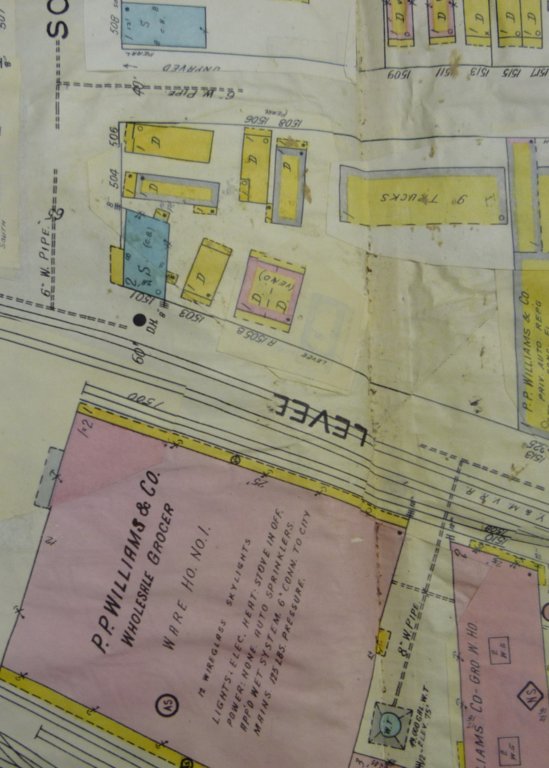 |
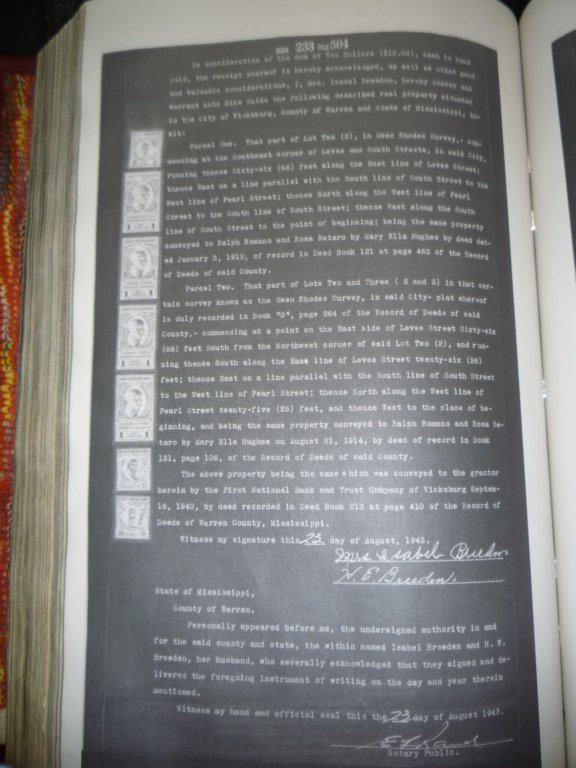 |
| Aerial
photograph of 1501 Levee St and environs,
in 1932. It is the small gray building with a dark roof, at
center on the corner of two streets. Note the
telephone pole and what appears to be a tree on the corner next to the
building. The P. P. Williams & Co. buildings are in the lower
left,
marked by a tall water tower. South St runs uphill behind 1501 Levee St. |
Sanborn
insurance map of 1501 Levee St (blue structure at the center left) and
environs, showing a two story concrete block building. Blue denotes
stone
or concrete block, red denotes brick and yellow denotes frame
construction. |
Deed
recording the sale of 1501-1505 Levee from Isabel and H. E. Breeden to
Mike
Guido on August 23, 1943. The tax stamps are a total of $4.40. |
On August 23, 1943, Mike Guido purchased the two parcels for $4,400. In
the 1944 address directory, the place was listed as a
"restaurant" having a telephone, with Michael Guido proprietor. In the
1948-49 directory, it was listed as "Mike's Place" and selling beer. On
May 13, 1950, Guido sold the two parcels to Lawrence and Ruth Nosser
for $9,900. The Nossers apparently owned the property until 1954 or
1955, and
operated it as a bar or restaurant called "The Shamrock". In the
1950-51 directory the location was listed as "retail beer" and in the
1953 it was listed as vacant. Most surviving Nosser family
members do not recall the place at all. Larry Nosser's
sister-in-law recently said she remembered that it was "some kind of
pool hall" (Nosser, 2008), but she may have been recalling Nosser's
more successful billiards room,
called "Nosser's Smoke House", located on Washington St, which was
listed as offering
"pool, cigars, tobaccos, sports results and beverages".
On December 5,
1953, a severe tornado hit Vicksburg
killing 38 people and destroying nearly 1000 buildings. The western
edge of the tornado passed over 1501 Levee St damaging several P. P.
Williams buildings both across the street from and adjacent to 1501
Levee. The frame houses on the property sustained significant damage
but 1501 Levee St itself appeared to have less severe damage (broken
windows and torn awnings). Photographs of the devastation provide a
record of how the building looked 10 years after Mike Guido opened his
cafe and 10 years after Ritchie's apparent "visit".
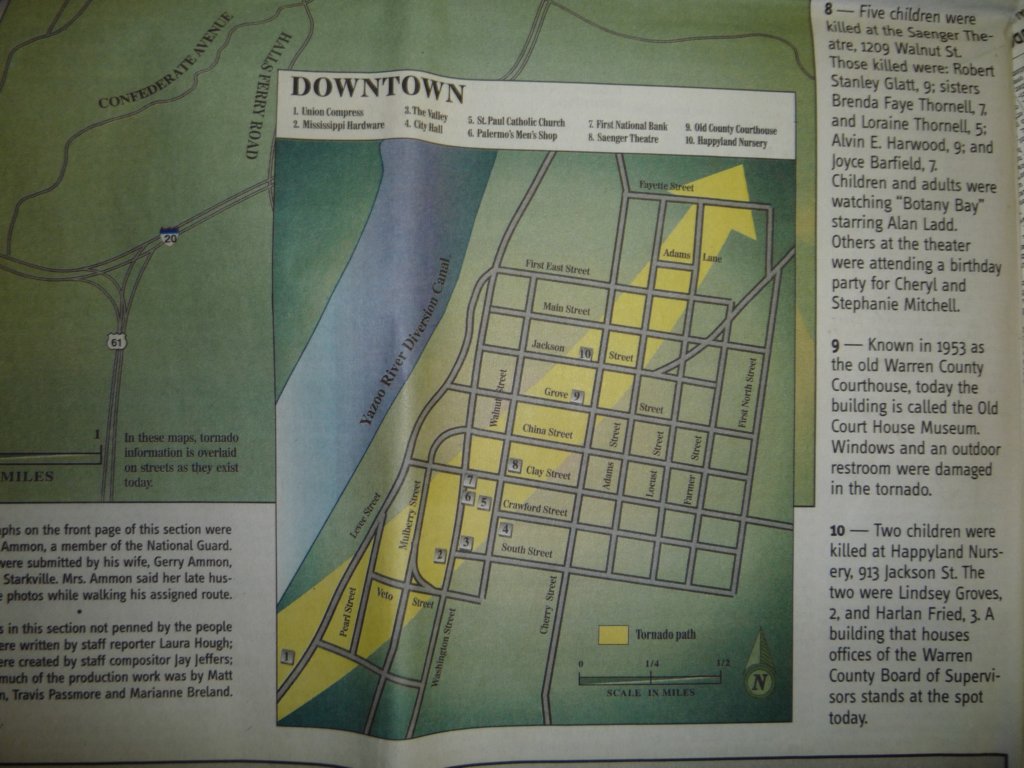 |
 |
| Path
of 1953 tornado through Vicksburg. The streets are not accurately drawn
(the west-most blocks of South St are missing). The 1501 Levee St
property
is located at the intersection of Levee and Pearl St. |
Front
of 1501 Levee St building after the 1953 tornado. The center door and
flanking windows are clearly visible. There may be writing above the
front door and left window and writing on the side of the building. The
odd structure on the side may be a second-story entrance to an enclosed
porch
with stairs to the ground. The P. P. Williams water tower is in
foreground. |
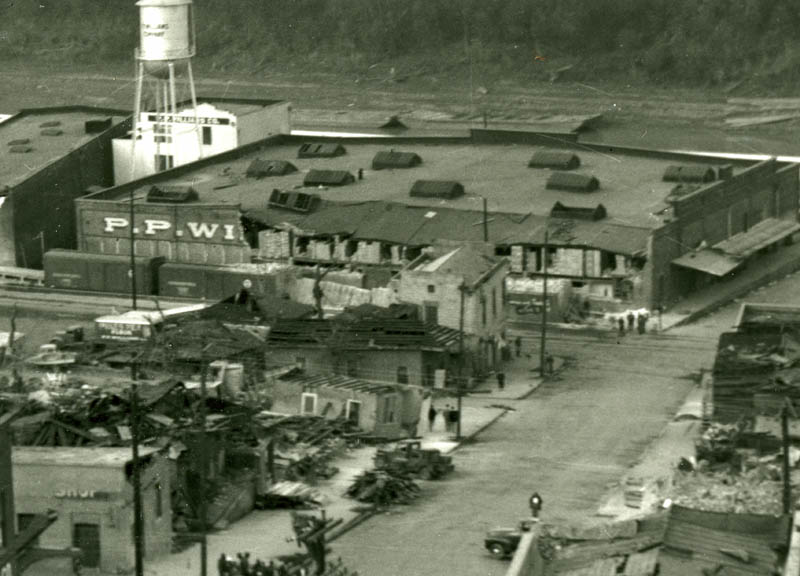 |
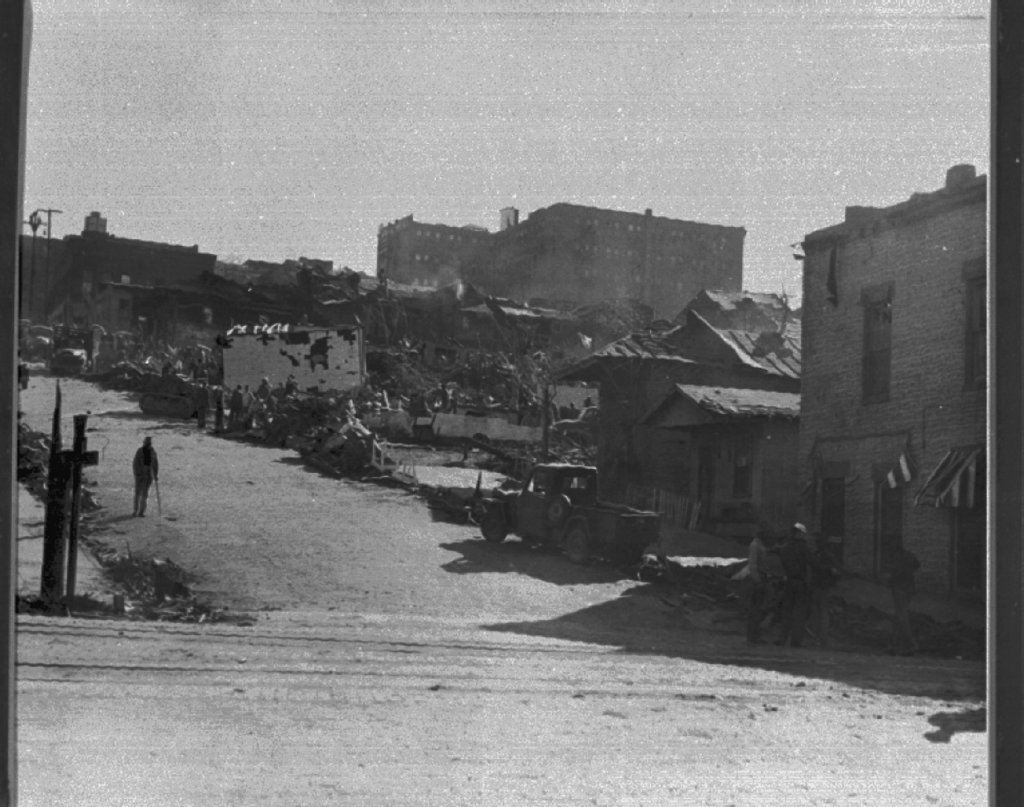 |
| Rear
of 1501 Levee St building after the 1953 tornado. The building is seen
down South St, at the bottom of the hill, on the left. Some cleanup has
already occurred, including installing replacement telephone poles (not
seen in the next picture, taken earlier). |
North
side of 1501 Levee St after the 1953 tornado. This view is looking up
South St from Levee St and the cafe building is on the right. The
concrete block construction is clearly visible. Torn
awnings and broken windows are visible. Damage to the adjacent frame
houses is also evident. The National Park Hotel is seen in the
background above Levee St. |
After the tornado, the two parcels were sold to a
number of different owners. The building served as a restaurant or bar
called
"The Shamrock" (1955-61), "Seawall Cafe" (1962-67) and finally
"Bar-B-Cue House" (1969-70). From 1971-74 it was listed as "vacant" and
from 1975 on there was no listing for this address: the building was
torn down as part of urban renewal. The property
currently houses two large metal storage buildings. The site of the
main P.
P. Williams & Co. building is now the parking lot for a casino.
Could
1501 Levee have been the
all-night cafe?
A number of details of George Ritchie's description of the all-night
cafe are supported by the evidence from 1501 Levee St. First, this
building fits Ritchie's story of driving down to the river and seeing
the cafe on the left. It is a rectangular building with a door flanked
by two large windows. Pabst Blue Ribbon Beer neon signs were very
common in restaurants and cafes around this time and many of these
signs have been recovered in recent years from buildings prior to
renovation or
demolition (Tuminello, 2008).
We have not yet been able to verify the color of the building's front
or the roof. From the tornado pictures, the north side and rear of the
building do not appear to have been painted. It was not uncommon for
building owners to paint concrete block buildings to try to improve
their attractiveness (Bell, 2008). From the aerial tornado picture,
there may be writing above the front door and left window and writing
on the south side of the building (possibly ending in "Corp" or
"Comp"...). There are many examples of Vickburg buildings painted with
advertisements visible from the Yazoo River or from other vantage
points. If Mike Guido painted the south side of the building for
advertising, he may well have also painted the front (west side) of the
building to advertise his cafe and thus the front may have been white.
Preliminary color analysis from
grayscale values of the picture of the rear of the building (above)
suggest that the roof color was probably "red in color or reddish
brown" (McCoy, 2009), although this result is not conclusive.
During World War II, Vicksburg was a major commercial transportation
hub
in the south. Merchant marines, Coast Guard personnel and
numerous workers from P. P. Williams & Co., Anderson
Tully and other manufacturing and shipping companies were all present
along Levee St. P. P. Williams and a number of other firms were
probably open all night (Tuminello, 2008). It is likely that an
all-night cafe would have been a successful venture in August 1943 when
Mike Guido purchased the building and converted it into a beer
establishment, possibly with one or more pool tables. Guido added
enough improvements to warrant more than double the value of the
two parcels, not counting the effect of inflation, from 1943 to 1950.
Return
to Vicksburg ten months later
In reference R2, Ritchie describes the car trip he and three other GIs
took from Richmond, Virginia to Abilene, Texas, returning to Camp
Barkeley: "We
spent
Monday night in Cincinnati, Ohio, and then drove all day Tuesday,
arriving in Vicksburg, Mississippi, around 9:00 p.m. While driving down
the street the next
morning, I could look over on the right and see the
Mississippi River (sic). Then I thought, 'Something looks very familiar
to me.' I looked over on the left and there stood the white all-night
cafe with the Pabst Blue Ribbon neon sign in the front window. I looked
down the river and there
was the big bridge crossing the Mississippi,
the one I had seen that night I was trying to get back to Richmond."
(R2, p. 51, italics added).
In reference R1, Ritchie describes driving through Vicksburg: "In
the city Pete
[the driver] took a street leading
down toward the
river. 'See any signs?' he asked me
over his shoulder. From my position
in the back of the seat I was supposed to keep an
eye out the left-hand window. I
didn't answer. For the
last mile my mouth had been feeling
dry, my stomach tight. Something about the layout of this town seemed
strangely, impossibly familiar: I knew I had never been there before,
and yet I knew exactly how the shoreline would look around the next
curve. How the streets would intersect. There! Just as I'd known they
would! And all at once I knew for sure that straight ahead on that very
street we would come in a few blocks to a white frame
building with a
red roof and the word 'Cafe' in neon letters over the door." (R1, pp.
97-98, italics added)
In the R1 account, Ritchie gives us several details of the drive
through Vicksburg: (1) they drove down to the Yazoo River, (2) they
drove for a considerable distance through the city ("for the last
mile") and (3) the cafe was straight ahead on the same street they were
driving down. Given the details of the R1 account, it is clear that the
R2 account is a short summary of the trip, but it contains additional
details: (4) they stayed over night in Vicksburg, probably in a hotel
and (5) he saw and recognized the large bridge over the Mississippi
River (south of Vicksburg but still visible from it).
Starting with these details, the trip from Cincinnati to Vicksburg is
about 700 miles, probably taking 13-14 hours, so it is very likely that
they arrived after dark, as stated in R2. During the war, there were
three hotels recommended for servicemen staying in Vicksburg, listed in
the Serviceman's Guide
to Vicksburg Mississippi, namely
Hotel Vicksburg, National Park Hotel and Hotel Carroll (Mississippi
Writer's Project, 1942). It is very likely that the four GIs stayed in
one of these hotels.
Their actions the next morning pose a problem: why did the GIs drive
down to the river when the shortest route to the bridge across the
Mississippi was to go south
on Washington St, rather than toward the Yazoo River? There are a
number of possibilities, as this would be their last stop before
resuming their basic training. They probably had to get gas for their
car. They may have wanted to pick up some groceries, and/or
ice, and/or beer or liquor. In addition, one or more of the
GIs may have wanted to drive past and
look at 15 China St, a well-known "house of ill-repute", deemed to be
the most notorious address in Vicksburg, having nationwide recognition
(Cotton, 1984), although this establishment was no more than a
flophouse in 1944 (Cotton, 2009).
These stops could have taken them to a number of different places
including down to Levee St for groceries at the People's Grocery Store
on the corner of China St and Levee St. Ritchie said that they had been
driving through Vicksburg for about a mile and drove down to the river.
A detour that included a stop at the People's Grocery Store (1201
Levee) would first take them north
on Washington St, then left on China St and finally end at the river on
Levee St. From this position, the story given in R1 (turn left to get
to the bridge, no keep going straight) makes sense. And straight ahead,
on the left, two blocks from the first sign to the bridge was 1501
Levee St.
Map of
downtown
Vicksburg (west is at top of map), showing the possible routes driven
by the four
GIs in October 1944, from one of the three hotels, down the steep hill
of China St to People's Grocery on Levee St at the Yazoo River.
Locations of gas stations and T. M. Morrissey Beer (off the map two
blocks further, at 923 Washington St) are shown.
The proposed path of Ritchie's "flight", across the Yazoo River and the
large P. P. Williams & Co. building to just above "Mike's
Place", is
shown in yellow at the top.
The three possible hotels the GIs probably stayed at are shown: the
National Park Hotel, the Carroll Hotel and Hotel Vicksburg. The route
to the bridge is to the
left along Washington St (blue arrow on left).
The possible routes taken by the GIs going down to the river are in
magenta. Just past 15 China St and along Levee St, we estimate that
Ritchie would have been able to see the large bridge over the
Mississippi River. It is certainly visible today from Levee St.
The two routes back up to the bridge are shown as blue arrows. There
would have been signs at these points to go back up the hill to
Washington St to get to the bridge (Tuminello, 2008). |
|
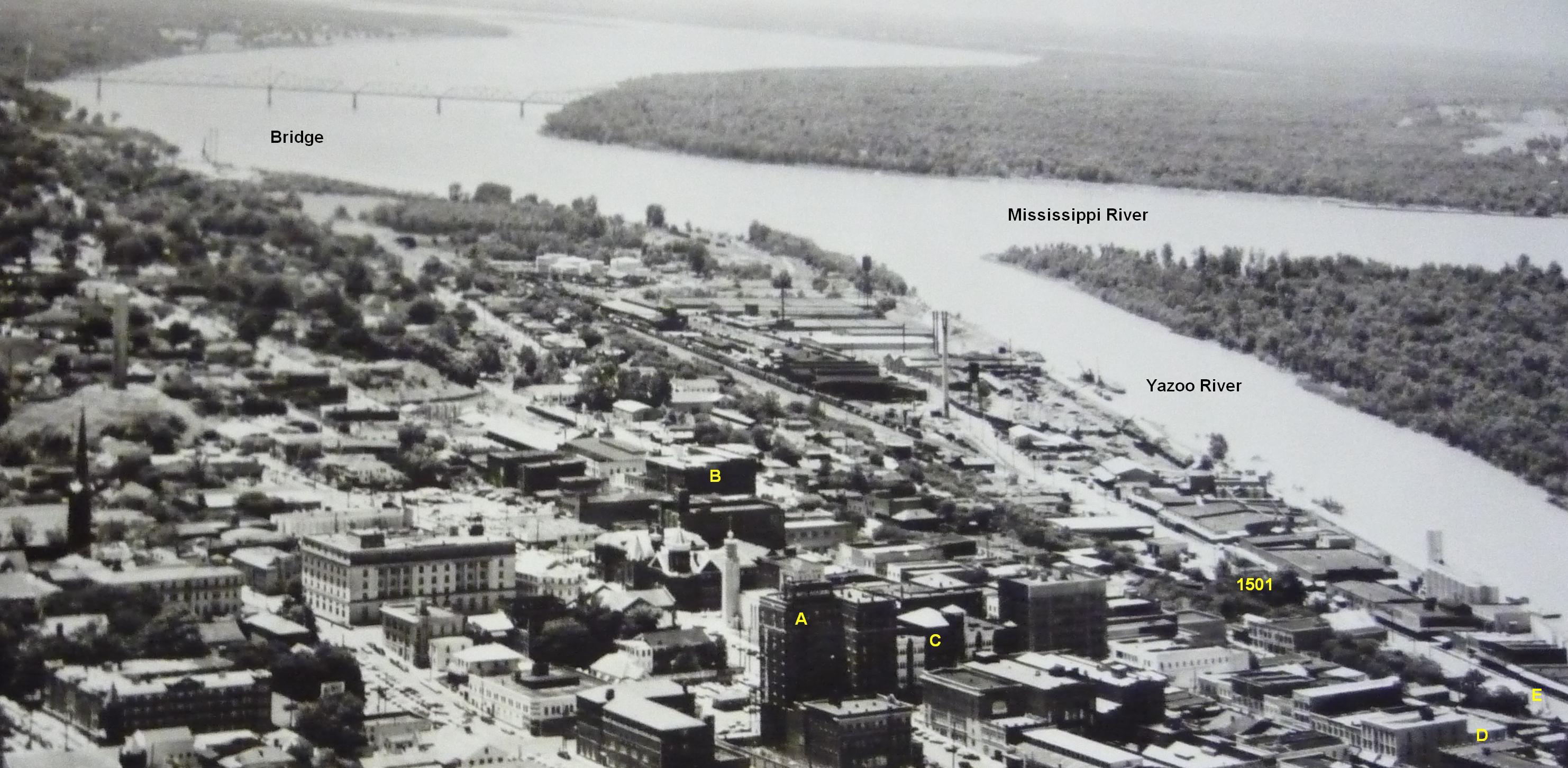 |
| Aerial
view of Vicksburg toward
southwest, circa 1960s: A:
Hotel Vicksburg, B:
National Park Hotel, C:
Carroll Hotel, D: China
St, E:
Levee St (lower right). Along Levee St, 1501 Levee is shown (the
building is mostly obscured by trees). From the layout of
buildings in 1944, we estimate that the distinctive form of
the
bridge south of Vicksburg would have been visible while driving down
China St toward the Yazoo River and along Levee St. Larger
image (2.4M) |
Given the R1 narrative, this proposed route through Vicksburg is
plausible and suggests that the GIs stayed at the National Park Hotel
because the trip would have been longer and Ritchie would have had a
chance to look down the hill on South St to the river and the P. P.
Williams buildings ("For
the
last mile ... Something about the layout of this town
seemed
strangely, impossibly familiar.").
For George Ritchie, the experience of his trip through Vicksburg going
back to Camp Barkeley served as corroboration that his out-of-body
perceptions had been real: he recognized
a number of aspects of the place he had "visited" and verified that his
perceptions had been accurate. For him, this verification then verified
all of the other aspects of his deep near-death experience: "So
it was here! Vicksburg, Mississippi. Here was where I stopped in that
headlong bodiless flight. Here I stopped, and thought, and turned
back..."
(R1, p. 99, italics in original). "[The correspondence of
the building and topography with his memory] removed any
possibility of my experience being a delusion or a dream as so many
skeptics wanted to believe." (R2, p. 26).
top
There are hundreds accounts of NDE OBE perceptions which are
claimed to be veridical or real. Usually the perceptions are checked by
the NDEr himself soon after the experience (as with Ritchie) or they
are are verified by asking one other witness. As a rule, NDE OBE
perceptions are found informally
to be veridical, that is, they appeared real, were checked with
witnesses, and were verified. In contrast, reports that perceptions in
an NDE were found to be non-veridical
are very rare (Holden, 2009). There
are several possible explanations why NDE OBE perceptions appear to be
veridical:
- The perceptions appear to be veridical but in
fact are unreal, just illusions or false memories.
The usual mechanism suggested for the formation of these perceptions
and memories about them is a malfunction of the brain caused by hypoxia
or similar deficiency. This explanation does not explain why the
perceptions are described as extremely lucid or vivid and how
veridical perceptions of unfamiliar events or locations, such as an
unfamiliar
place more than 500 miles distant, could be formed by brain malfunction.
- The claimed perceptions are
actually deliberately fabricated by the experiencer to deceive others.
This explanation does not
seem very plausible in light of the hundreds of such reported cases
(were they all trying to deceive) and the extreme reluctance of the
experiencers, including Ritchie, generally have in telling others about
their experience (if they are making up a "proof" of their experience,
why aren't they broadcasting it to the world). In Ritchie's case, it
doesn't explain the apparently good correspondence of his account of
passing over multiple blinking caution lights with a path over Tyler,
Texas when that detail has only now been noted.
- The claimed perceptions are not deliberate
fabrications but are subconsciously developed out of some psychological
need and manifest as déjà
vu
experiences. This is the explanation given by Paul Edwards
(1996):
"...the sights
of [Vicksburg] including the cafe seemed familiar and
were at once interpreted as identical with certain of the objects
'seen' in the early phase of George's astral trip. The various
physiological changes--if they really happened--made the whole thing
emotionally all the more impressive to him. It seems to me entirely
possible that there was not even a silent prediction about the location
of the all-night cafe. When it came into view it seemed familiar as did
other objects in Vicksburg." (pp. 125-126).
Edwards'
explanation is a variation of the deception explanation but
includes self-deception. Edwards
supplied no justification for Ritchie's perceptions being déjà vu,
and his use of the term déjà
vu
is
incorrectly applied to Ritchie’s
experience. The standard definition of déjà
vu, “any subjectively inappropriate impression of
familiarity of a present
experience with an undefined past” (Brown, 2004, p 12), does
not apply, because
Ritchie stated that he recognized
specific
details of the building and the locale from memory of a
specific experience,
hardly an “impression of familiarity with an undefined
past.” Edwards' explanation also appears implausible in light
of
(1) the vividness of Ritchie's perceptions, (2) his great reluctance to
share his experience with others (if he had successfully deceived
himself, why not tell the world about the "proof"), and (3) the
correspondence of other details of the story which Ritchie didn't even
notice (the exact correspondence of latitudes in three places, the
blinking caution lights).
- The
perceptions are in fact veridical and the mind is somehow operating and
perceiving at a large distance from the physical body. Given the NDEr's
sense of complete separation from, and even alienation from, the
physical body, it is likely that the mind is operating independent of
the physical body.
Conclusions
One objective we had in this investigation was to see if the details of
an NDE could be verified simply from objective details of the
narrative, even though many years had passed and all of the principals
had passed away. George Ritchie's NDE account was sufficiently rich in
details of objective locations, buildings and events in the world that
a reasonable verification of those details was possible. In this
respect we feel that we have demonstrated
the validity of trying to verify the details of purported veridical
perceptions, even
long after the fact.
Ritchie's
own recognition of the cafe building and topography, as verification of
his
out-of-body perceptions, stands on its own
merits. It is difficult to find an alternate explanation for the
accuracy of his perceptions of an unfamiliar location so far distant
from his physical body at a time when he was declared dead, other than
that his mind had somehow in fact "traveled" to the location and
actually perceived them.
Our work to verify the details of his story strengthens the
credibility of his account. It is an objective fact that Vicksburg was
due east of the
Camp Barkeley station hospital. The maximum deviation in travel from
exactly
due east would be no more than 0.6 seconds of arc over a distance of
523
miles. The correspondence of three aspects of Ritchie's account with
likely correlates in the physical world, all at the exact same latitude,
makes a strong case that his perceptions were in fact
veridical:
- Ritchie described leaving the rear door of a
ward
building that was near the x-ray department of the station hospital.
There was a ward building whose rear door was at the appropriate
latitude, which was likely near the hospital's x-ray department.
- Ritchie described passing over a town with
multiple
blinking caution lights at intersections. The main street in
Tyler, Texas ran directly east-west and lay just north of the
appropriate latitude. At the time, Tyler had four traffic lights along
this path that were set to caution blinking at
night.
- Ritchie described arriving directly over an
all-night
cafe in a city by a very large river with a large bridge, which he
later recognized was Vicksburg, Mississippi. There was a cafe at the
appropriate latitude at 1501 Levee St matching the description
Ritchie gave and matching the story of his return visit to Vicksburg.
Although Ritchie later saw and recognized the building and his later
perceptions could have influenced his written accounts, his recognition
matched the reality in nearly all details (rectangular building, front
door flanked by two windows, telephone pole with a guy wire nearby,
situated by a large river with a large bridge nearby) and matched other
details which were very likely the case (Pabst blue neon sign,
all-night operation).
In addition to these three aspects of his account, Ritchie also
described recognizing that he was traveling east by the position of the
North Star in the clear night sky, to his left. The fact that three key
aspects of the account have likely correlates at the exact same
latitude and that Ritchie reports having traveled east strongly suggest
that an objective,
albeit unusual event occurred. It is highly unlikely that Ritchie could
have imagined events, or had déjà
vu
of experiences, with such strong physical correlations: a particular
ward building rear door, a particular street with multiple caution
lights and a particular cafe in a city on the far shore of a large
river. It is highly unlikely that Ritchie could have fabricated such an
account where the details have only now been shown to be so
highly correlated, and where one of the aspects (the caution lights)
was
mentioned apparently only in passing.
Two of these three aspects of Ritchie's experience need further
verification:
- The color of front of 1501 Levee St and the
color of the roof, evidence of all-night operation, etc.
- Ritchie's hospital medical records, showing the
ward he was in, and a detailed layout of the station hospital buildings
in the complex including the location of the x-ray department.
It is very likely that some of these
details can no longer be verified, but we continue to
investigate
all of these open questions.
References
Bell, Nancy (2008). Personal
communication on July 31, 2008. Nancy Bell is the executive
director of the Vicksburg
Foundation for Historic Preservation.
Brown,
A. S. (2004). The déjà
vu experience. New York: Psychology Press.
Cotton,
Gordon
(1984). 15 China and
other tales, pp. 8-13. Raymond, MS: Keith Printing.
Cotton,
Gordon (2009). Personal communication on July 20, 2009. Gordon Cotton
is a lifelong resident of Vicksburg, local
historian and past
curator of the Old
Court House
Museum (Vicksburg and Warren County Historical Society).
Edwards,
P. (1996). Reincarnation: A
critical examination. Amherst, NY: Prometheus.
Holden,
J. M. (2009). Veridical perceptions in
near-death experiences. In J. M. Holden, B. Greyson, & D. James
(Eds.), The Handbook of Near-death
experiences: Thirty years of investigation. Westport, CT: Praeger
Publishers.
McCoy, M. (2009).
Personal communication on May 24, 2009. Mike McCoy is owner of
L&L Photo in Vicksburg and does colorization
of black and white
photographs using grayscale analysis.
McNamara, Mary Jane
(2009). Personal communication on July 23, 2009. Ms. McNamara serves on
the Board of Governors of the Smith
County (Texas) Historical Society.
She grew up in Tyler and was a teenager there in the early 1940s.
Mississippi Writer's
Project (1942). Serviceman's
Guide to Vicksburg Mississippi. Jackson, MS: Work Projects
Administration, January, 1942.
Nosser, Johnnie
(2008). Personal communication on July 31, 2008. Mr. Nosser is the
nephew
of Lawrence Nosser.
Rees, Gerald (1943).
Letter from Camp Barkeley, July 2, 1943. In Center for
Archival Collections: Gerald Rees Papers, Transcripts: July 1943, MS-1007.
Ritchie,
George (1998) (R2). Ordered
to Return: My life after dying. Charlottesville, VA:
Hampton Roads Publishing. Originally published as My Life after Dying,
1991.
Ritchie, George
(2006). Personal communication on November 22, 2006.
Ritchie, George and
Elizabeth Sherrill (1978) (R1). Return
from Tomorrow. Waco, TX: Chosen Books Publishing.
Sherrill, Elizabeth
(2006). Return from
Tomorrow web page, describing how the book was written. http://www.elizabethsherrill.com/sherrill_return_from_tomorrow.html
Spraggett, Allen
(1974). The Case for
Immortality. New York: Signet.
Tuminello, Skip
(2008). Personal communication on July 30, 2008. S. J. (Skip) Tuminello
is an architect and life-long native of
Vicksburg who
specializes in the restoration of historic buildings. He served as vice
president of the Mississippi Historic Foundation of Vicksburg.
Acknowledgements
We are indebted to a number of people who have helped this research
including Mike McCoy, Dr. Vernon Williams, Skip
Tuminello, Nancy
Bell, Mary Jane McNamara, Gordon Cotton,
George Bolm, Christine Chouccoli,
Johnnie Nosser, Dr. Gary Lindsey, and Mike Hernandez.
|

